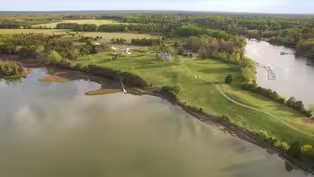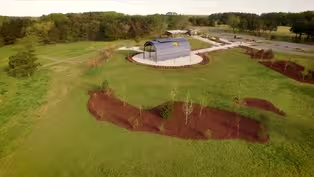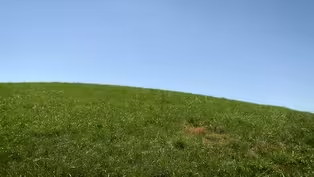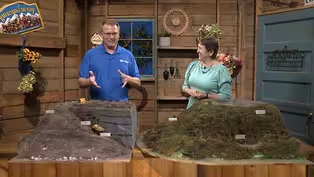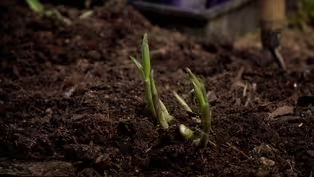Virginia Home Grown
Native Trees
Clip: Season 23 Episode 2 | 5m 55sVideo has Closed Captions
Learn about native tree species being encouraged to grow at Machicomoco State Park
Terry Sims, Park Manager at Machicomoco State Park shows specimens of native trees that the park rangers are encouraged to grow at the site and talks about the connection of plants to Native American history and culture. Featured on VHG episode 2302; April 2023.
Problems playing video? | Closed Captioning Feedback
Problems playing video? | Closed Captioning Feedback
Virginia Home Grown is a local public television program presented by VPM
Virginia Home Grown
Native Trees
Clip: Season 23 Episode 2 | 5m 55sVideo has Closed Captions
Terry Sims, Park Manager at Machicomoco State Park shows specimens of native trees that the park rangers are encouraged to grow at the site and talks about the connection of plants to Native American history and culture. Featured on VHG episode 2302; April 2023.
Problems playing video? | Closed Captioning Feedback
How to Watch Virginia Home Grown
Virginia Home Grown is available to stream on pbs.org and the free PBS App, available on iPhone, Apple TV, Android TV, Android smartphones, Amazon Fire TV, Amazon Fire Tablet, Roku, Samsung Smart TV, and Vizio.
Providing Support for PBS.org
Learn Moreabout PBS online sponsorshipWell, Terry, you've got quite an interesting array of plants here, you know.
I'm so excited to see trees on this table.
So what can you tell me about them?
>>Well, we definitely brought several clippings from Machicomoco that we are encouraging to grow there.
And we did bring some of the ones that we are trying to get rid of as well.
But the first couple that I'm gonna talk about are our pine trees.
These are two different species here.
>>And they're both natives.
>>Both natives to Virginia.
We have the Loblolly pine, and you can see that we have the cone that goes with it, very original cone that you see throughout Virginia.
And then one that's really beautiful that we have growing at our park, we have actually 60 acres of this.
This is our longleaf pine.
>>Very unusual to be so far up in Gloucester like that.
>>Yeah, definitely, we're at the top part of the growth pattern.
And this was actually planted by the housing developer before it became a state park, he planted the 60 acres.
And so definitely come out and experience that.
It is really beautiful.
>>But the cones for that pine, ah.
>>Oh, these are amazing.
>>They are amazing.
>>You can find these out there while you're exploring the park.
>>I have to share with you, my mother-in-law, rest her soul, she would gather these cones when she went south.
She lived in Pennsylvania.
She'd make turkeys out of 'em at Thanksgivings.
So funny, and just silly little things, whenever I'd see this cone.
Enough of that silliness.
So what else do you have growing at the park?
>>Well, right here, the next one is honey locust.
This one you'll find throughout our interpretive area.
This one we planted there.
It was planted there with the intent to kinda show what the indigenous people would use to build their yi-hakans, or their long homes.
But the honey locust wasn't really the one that they used.
They would use the black locust.
>>Yes, our native black locust.
>>But with the black locust, we didn't want to plant those in the interpretive area because they have those really sharp thorns and stuff.
>>Oh my, and those are so painful.
>>Definitely.
>>Well, you're being very family friendly then, by putting in the honey locust and telling the same story.
>>Definitely, it's a beautiful tree.
>>It is a beautiful tree, one that, I think, people should use more in their yards.
But you've got some of my favorites here, and I know it's springtime, and it's coming along.
It's doing the best best it can, given our weather conditions.
>>This clipping is of a bald cypress.
This one has a unique history to it as well.
The indigenous peoples would use the bald cypress to create their canoes and stuff, whatever they would travel on the water.
One unique thing about it, it has a feature of.
>>Of growing those knees?
>>Yes.
(laughing) Thank you.
>>You're welcome.
And they really don't understand why the knees are grown.
They've had all these theories over the decades, over time, but nobody's ever be able to confirm this is why they're there, which is very intriguing.
And the other thing that I've always found with bald cypress is yes, they like it wet and they grow in swampy areas, but they also can grow high and dry.
And so many people don't realize that, is that the dry soil has just as little oxygen as that wet soil.
So it's an interesting tree.
>>It's a really beautiful tree, one of my favorite whenever you're exploring out there.
>>Yes, and so soft.
Texturally, it's fun.
Well, we've got two here, and we've got our regular red maple here.
>>The red maple, this is a really beautiful tree that you'll find throughout our park.
Again, you'll find this one in our interpretive area that surrounds the yi-hakan.
The unique feature with this one, and the history about it, was the indigenous peoples would use this as the cross beams for their support of the house.
So it's really beautiful.
>>That is beautiful.
And I threw in, asked you to put this sweet gum in, and we'll do it real quick 'cause we wanna get over to the invasives.
But so many people confuse this as a maple when it's our sweet gum.
>>Yeah, it does look like a maple, but no, this is a maple tree.
This one again is found throughout our park.
It is a really fast-growing tree.
So it'll be in your early succession fields.
So it'll provide really nice shade if you're wanting something really quick.
>>And beautiful fall color too.
>>Very beautiful.
>>Beautiful sweet gum.
It's just lovely.
I know it has the sweet gum balls, but you can forgive it.
Well, these have been great examples of some of our positives, but we have just one minute left to talk about the not so positives.
>>So these, yes, these are the ones that are giving us challenge at the park, and it gives many people challenges throughout Virginia.
This one is our Callery pear.
It is all over the place.
It is something that we are battling with daily to try to get rid of.
It has these sharp thorns on it that are very nasty.
>>Yes, and it doesn't make up for the white flowers in the spring 'cause it's just, it's a monster.
And speaking of, we have this one too.
You have this on throughout the property?
>>We do have this one throughout the property.
And even though it's given a tree of heaven as a heavenly name, (Peggy laughing) it is very invasive and we definitely do not want it to be growing throughout.
>>The problem with this plant is it can grow just about anywhere, and you can cut it down, and then it sprouts from the roots like it's got a message to share, almost as if it's insulted.
Well, Terry, this has been great.
Thank you so much for bringing in some of our native trees that are growing at the park, but also showing some of the challenges.
We appreciate it.
>>Thank you.
Video has Closed Captions
Clip: S23 Ep2 | 26m 46s | Learn about efforts to protect and restore natural areas in Virginia! (26m 46s)
Video has Closed Captions
Clip: S23 Ep2 | 2m 19s | Conserve water and suppress weeds by using wood chips in the garden. (2m 19s)
Video has Closed Captions
Clip: S23 Ep2 | 7m 11s | Explore Virginia’s first state park dedicated to honoring Native American history. (7m 11s)
Video has Closed Captions
Clip: S23 Ep2 | 7m 57s | Learn about a mining company’s industry-leading environmental stewardship program. (7m 57s)
Video has Closed Captions
Clip: S23 Ep2 | 6m 39s | Overseeing Mine Site Restoration (6m 39s)
Video has Closed Captions
Clip: S23 Ep2 | 3m 7s | Preserve soil on sloped landscapes by planting groundcover. (3m 7s)
Providing Support for PBS.org
Learn Moreabout PBS online sponsorship

- Home and How To

Hit the road in a classic car for a tour through Great Britain with two antiques experts.












Support for PBS provided by:
Virginia Home Grown is a local public television program presented by VPM
